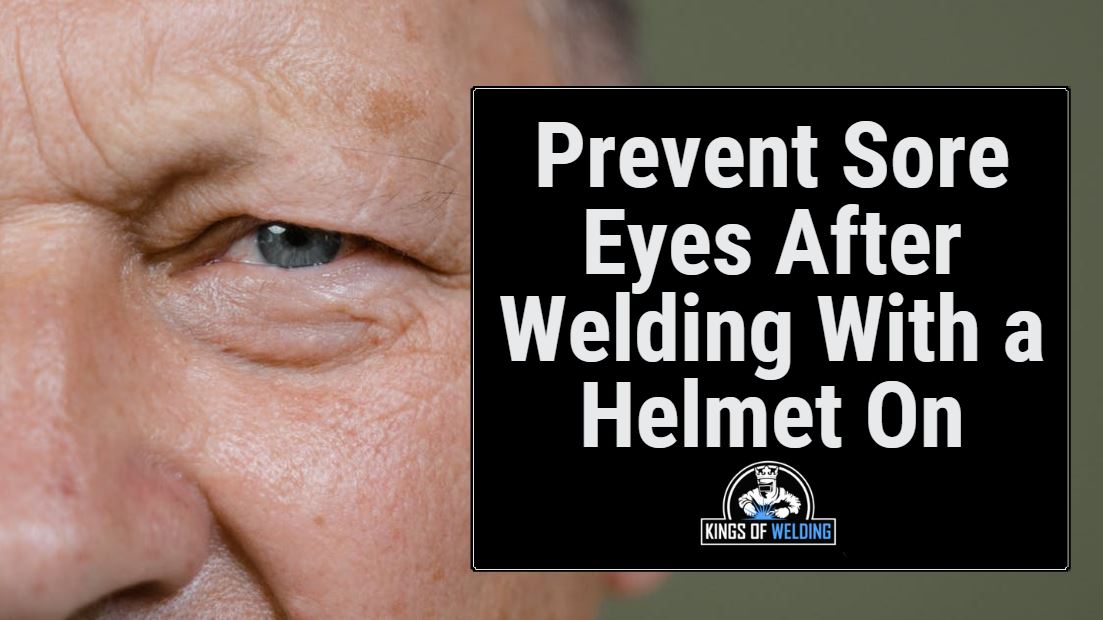If you’ve worn your welding helmet but still have sore eyes after welding, you might be wondering what you’ve done wrong. Surely, a welding helmet is supposed to stop your eyes from hurting?
Well, there are a number of reasons why your eyes might be hurting even after wearing a helmet and it might not even be welder’s flash that’s causing the problem.
Read below to see the possible causes and the things you can do to help prevent your eyes hurting in the future.
Reduce eye strain
If your eyes are giving a sensation like you have sand in them after welding, then you most likely have welder’s flash. However, sore and aching eyes might be caused by eye strain.
You need to make sure you can clearly see the joint you’re welding and aren’t continuously straining your eyes. The following steps will step:
- Cleaning the lens can help improve visibility and reduce straining.
- Having a well lit workplace will also help reduce eye strain.
- Book an eye test to check your vision.
- Inserting a cheater lens into the welding helmet will magnify your work through the lens and can help reduce eye strain.
Ensure the helmet has power
One of the most common ways that an auto-darkening helmet can underperform is by having low power.
If you have a battery powered helmet then try changing the battery as it could be running low and slowing the sensors down. If it runs off solar power, make sure it’s fully charged before you start welding.
Wear welding goggles or safety glasses
Wearing a welding helmet will drastically increase your eye protection compared to not wearing one, but they still leave you partially exposed to dust and radiation which can cause your eyes to hurt.
Wearing ANSI Z87.1 standard welding goggles or safety glasses with side shields under your welding helmet will add an extra layer of increased protection which could prevent eye damage and stop them from hurting.
If you choose not to wear welding glasses because you already wear prescription glasses for your vision, then consider wearing contact lenses. Contact lenses are widely acknowledged to be safe to wear when welding and you can then wear your welding glasses and helmet over your contact lenses and have extra protection whilst being able to see clearly.
Improve arc sensors
Check the rating of the lens reaction time on your auto-darkening helmet. The best welding helmets on the market have sensors that can react to the arc in under 1/20,000 of a second and give your eyes maximum protection. Cheaper auto darkening helmets are typically less responsive.
The number of arc sensors can also have an impact in how they react to the arc. Top rated helmets typically have three or more arc sensors to help them react effectively and give your eyes maximum protection.
Reduce fume exposure
Sore eyes can be caused by welding fumes entering the welding helmet and coming into contact with your eyes. Ensure your workplace has adequate ventilation to help reduce welding fumes.
Wearing an air fed welding helmet (PAPR) will also help improve the quality of air inside the helmet and reduce the levels of dangerous fumes coming into contact with your eyes.
Maintain welding helmet
Ensure your welding helmet is maintained in good condition to prevent harmful UV light and radiation from entering it. If you have an old helmet that’s battered and bruised it might have broken parts where harmful UV rays are entering it and causing damage to your eyes. Check that there are no loose parts, particularly around the glass, and look after your helmet!
Check delay settings
Check the “delay” settings on your auto-darkening helmet. Delay refers to the length of time before the lens lightens after it has stopped detecting the arc. A low delay setting means that it will quickly change from the dark state.
Try increasing the delay settings so you get a little bit longer after the arc has stopped before the lens turns lighter just to give you that extra bit of protection from any bright light.

